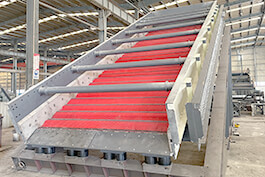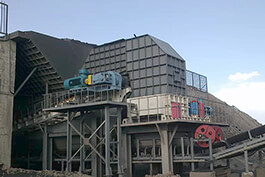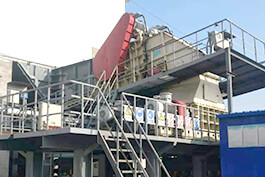In industrial fields such as mineral processing, coal sorting, and aggregate production, screening equipment is the core equipment for achieving material classification and purification. The structural design of Banana Screen has many advantages in terms of high processing capacity and high screening efficiency. Compared with traditional horizontal screens or single-angle screens, the multi-angle design of Banana Screen It enables precise control of the flow rate of materials during the screening process, ensuring not only the rapid passage of a large amount of materials but also the effect of fine classification.
Structural design of Banana Screen
Multi-segment inclination Angle
The entire Screen surface of the Banana Screen is not a single plane. Instead, it is continuously spliced together by 3 to 5 screen sections (the specific number is adjusted according to the processing requirements) with decreasing inclination angles in sequence, forming an arc-shaped contour similar to the curvature of a banana. The gradient inclination Angle design enables the material to enter the screen surface from the feeding end with a high inclination Angle during the screening process. Under the dual effects of gravity and vibration, it will move forward at a relatively fast flow rate. Fine particles smaller than the screen holes will quickly pass through the screen, achieving initial rapid classification. As the material enters the subsequent screen section with a gradually decreasing inclination Angle, the flow rate decreases accordingly, and the residence time of the material on the screen surface is prolonged, providing more sufficient opportunities for passing through the screen, thereby achieving fine screening.
Screen frame
The Screen body frame of Banana Screen, the basic load-bearing structure, supports the vibration system, the screen surface and all material loads. Its structural strength and rigidity directly determine the operational stability and service life of the equipment. The frame of the screen body is usually made of high-strength low-alloy structural steel through an overall welding process. The key load-bearing parts are also strengthened with thickened steel plates or reinforcing ribs. When the Banana Screen is in operation, it generates high-frequency and high-intensity vibrations. The frame needs to withstand periodic dynamic loads. If the rigidity is insufficient or the welding quality is poor, problems such as frame deformation and weld cracking are very likely to occur.

Drive and vibration system
Vibrator/exciter
The commonly used excitation box of Banana Screen contains eccentric blocks, bearings and transmission shafts. The vibration box is driven by a motor to rotate the eccentric block at high speed. Vibration is generated by the centrifugal force of the eccentric block. This structure can produce a greater vibration force and is suitable for large Banana screens with a large processing capacity and coarser material particle size. The key parameters of the vibrator - amplitude, frequency and vibration direction Angle - all need to be precisely matched according to the properties of the screened materials (such as particle size, density and moisture content) and the screening requirements.
Couplings and transmission systems
Elastic couplings, due to their certain buffering and shock absorption performance, can effectively absorb the impact load during the start-up and operation of the motor and protect key components such as the bearings of the vibrator. They are more widely used in Banana screens. During the installation process, the connection between the drive shaft and the coupling and the vibrator must ensure coaxiality; otherwise, it will lead to severe vibration, increased noise and other problems during operation, accelerate component wear and shorten the service life of the equipment.
Screening medium and support
Sieve plate/sieve mesh
The sieve plate, also known as the sieve mesh, is the screening medium that directly contacts the material, achieving material classification. Its material, structure and fixation method directly affect the screening accuracy, service life and operating cost. The wear resistance, good elasticity and noise reduction performance of polyurethane screen plates make them the first choice for coarse aggregate screening scenarios in mines, coal and other industries. Their elasticity can also effectively reduce the impact of materials on the screen plates and extend their service life. Rubber screen plates have stronger corrosion resistance and buffering effect, and are suitable for screening materials containing acidic, alkaline and other corrosive components, or in environments with high requirements for screening noise.
The sieve plate supports the crossbeam
The function of the screen plate support crossbeam is to evenly transfer the material load and vibration load borne by the screen plate to the side plates of the screen body, while ensuring that the screen plate can be precisely arranged in strict accordance with the designed multi-segment inclination Angle. The supporting crossbeams are usually made of seamless steel pipes or I-beams. The spacing and cross-sectional dimensions of them need to be precisely calculated based on the material and size of the screen plates as well as the weight of the screened materials to ensure sufficient load-bearing capacity. If there is a deviation in the installation of the crossbeam, resulting in the screen surface inclination Angle not meeting the design requirements, it will directly affect the flow rate and residence time of the material on the screen surface, disrupt the screening rhythm of "fast at the front end and slow at the back end", and reduce the screening efficiency.
Shock absorption and isolation components
Support spring/rubber shock absorber
When the Banana Screen is working, it will generate strong vibrations. The main function of the support spring is to isolate the dynamic load of the screen body from the static foundation structure, playing the role of a "buffer". The commonly used shock-absorbing components at present mainly include steel helical springs, rubber springs and polyurethane buffers. Steel helical springs have advantages such as large load-bearing capacity, good resistance to high and low temperatures, and long service life. They are suitable for large-scale Banana screens or scenarios with harsh working conditions.
Vibration isolation device
The quality of vibration isolation effect directly affects the operational stability of banana screen and the surrounding environment. If the vibration isolation effect is poor, it will not only cause damage to the factory building structure, but also result in the waste of vibration energy and reduce the screening efficiency. It is necessary to precisely calculate the model, quantity and installation position of the vibration isolation device based on the vibration parameters, weight of the banana screen and the load-bearing capacity of the foundation structure.
Conclusion
Due to the collaborative and optimized design of its key structural components, Banana Screen can demonstrate outstanding screening performance in fields such as mineral, coal and aggregate processing. The multi-stage inclination Angle screen surface design, high-strength screen body frame, drive and vibration system, screening medium and support components, shock absorption and isolation system jointly ensure the long-term stable operation of the equipment.





.jpg)







